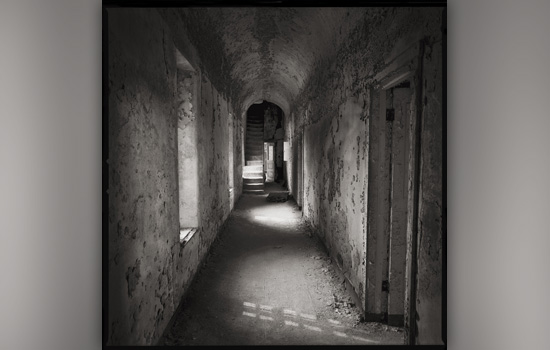Inside America’s first penitentiary
Eric T. Kunsman’s revealing photographs focus on wardens’ logbooks from the 1830s
Eric T. Kunsman
Eric T. Kunsman’s photograph of Warden’s Corridor is part of a historic exhibition at Dyer Arts Center that focuses on Philadelphia’s Eastern State Penitentiary, which closed its doors in 1971 and is now a U.S. National Historical Landmark.
One of the most famous penitentiaries in the world—now a haunting world of crumbling cellblocks and empty guard towers—is the subject of 11 years of research and an exhibition by photographer Eric T. Kunsman.
Eastern State Penitentiary, located in Philadelphia, is the focus of “Thou Art... Will Give...” a historic exhibition that runs from Nov. 21 through Jan. 21 in Dyer Arts Center at Rochester Institute of Technology’s National Technical Institute for the Deaf.
An opening talk with Kunsman will be held at 3 p.m. Friday, Nov. 21, followed by a reception from 4 to 8 p.m. A second discussion will be held at 4 p.m. Wednesday, Dec. 10. All events are free and open to the public.
According to Kunsman, the architectural design of the prison by John Haviland was based on the state’s Quaker Penal Code instituted by William Penn; each man and woman had to have a separate cell because isolation would give them time to ponder their mistakes and make peace with God. Famous inmates included two notorious criminals—bank robber Willy Sutton and gangster Al Capone.
“The whole idea of the word penitentiary comes from the word penance,” explained Kunsman, who became intrigued with Eastern State Penitentiary after reviewing wardens’ logbooks from the 1820s and 1830s at the American Philosophical Society in Philadelphia’s Independence Hall. Reproductions of these pages will be on display during the exhibition—intermingled with 100 large-scale format photographs from his 362 visits to the penitentiary.
“In my photos, you can see pictures of the wardens’ corridor, a theater stage, solitary cells with single glass skylights representing the ‘Eye of God,’ and the small doorways, which forced prisoners to bow in penitence when leaving or entering their cell,” explained Kunsman. “From the wardens’ logbooks, I noticed many similarities between the crimes committed back then and today—killing one’s spouse, stealing, embezzlement and rape.
“With lack of stimulation and living in solitary confinement, many people lost their sanity or died inside those prison walls between the years 1829 and 1971.”
A native of Bethlehem, Pa., Kunsman is a photographer, book artist, lecturer in NTID’s Visual Communications Studies Department and adjunct professor in RIT’s School of Photographic Arts and Sciences, and owner of Booksmart Studio in Rochester, N.Y.
The Dyer Arts Center, located at 52 Lomb Memorial Drive, is open from 9 a.m. to 4 p.m. Monday through Friday and by request. For more information, email dyerartscenter@rit.edu or call 585-475-6406.


